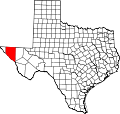Birchville, Texas | |
|---|---|
| Nickname: Smith's Ranch | |
| Coordinates: 31°22′30″N105°57′57″W / 31.37500°N 105.96583°W | |
| Country | United States |
| State | Texas |
| County | Hudspeth |
| Time zone | UTC-7 (Mountain (MST)) |
| • Summer (DST) | UTC-6 (MDT) |
| GNIS feature ID | 2034616 |
Birchville, or Smith Ranch, now a ghost town, was located in what is now Hudspeth County, Texas, United States. Birchville was a settlement on the San Antonio-El Paso Road in what was El Paso County. Birchville lay 35 miles northwest of the First Camp on Rio Grande and 24.8 miles southeast of San Elizario, according to the table of distances for the San Antonio-San Diego Mail Line in the Texas Almanac of 1857. [1] Later used as a station on the Butterfield Overland Mail, the distances to the station for that line were given as 241⁄2 miles from San Elizario, 33 miles from Fort Quitman. [2]

